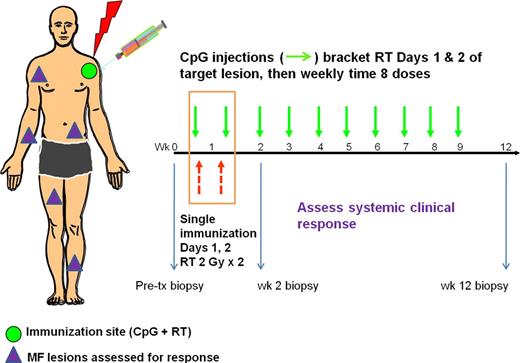Abstract
Abstract 286
In a murine model, our in situ vaccination therapy combining tumor antigens with TLR9 agonist cured mice of lymphoma. Our phase I/II study in indolent B-cell lymphoma demonstrated that this in situ vaccination maneuver utilizing local radiation to expose tumor antigens combined with CpG ODN was well-tolerated without treatment limiting toxicities. It induced meaningful systemic clinical responses and tumor-reactive memory CD8 T-cells. In parallel, we explored this in situ vaccination strategy in cutaneous T-cell lymphoma (CTCL), specifically mycosis fungoides (MF). Our objectives were to determine the feasibility and safety and to assess the local and systemic antitumor effects in MF.
Patients with MF stages IA-IVA who failed ≥1 standard therapy were eligible. Immunization site was treated with low-dose radiation (2 Gy × 2 d), bracketed by intratumoral injection of CpG followed by weekly intratumoral CpG × 8. Local (immunized site) and systemic antitumor responses were assessed at wk 0, 2, 4, 8, 12, then monthly until PD/off-study. Clinical response was evaluated by assessing skin disease burden at sites not treated with immunization procedure.
Study enrollment was completed with total of 15 patients. Median age was 57 yrs (range 18–71 yrs), 12 of 15 were male. Six patients had stage IB and 9 with stage IIB (3 with large-cell transformation). Median number of prior therapies was 5 with range of 2–9. After the initial 6 patients, a second immunization site was added at wk 4 to enhance systemic response. Total of 5 partial responses were observed (30% OR); 2 of 6 treated with single immunization and 3 of 9 with dual immunization. Median time to response was 8 wks (range 4–12 wks), duration of response 7 wks (range 4–44 wks), and time to progression 20+ wks (range 3–44+ wks). Patients with large-cell transformed MF did not respond. Common toxicities were injection site and flu-like symptoms; mostly grade 1–2 and all transient. No clinical or laboratory findings of any autoimmune disorder were observed. Local tissue tumor/immune responses were assessed by immunostaining. CpG + local radiation treated immunization site showed a significant reduction of CD25+, Foxp3+ T-cells (p<0.01) consisting of MF cells and tumor-infiltrating lymphocytes. Similar reduction in S100+, CD1a+ dendritic cells (DCs) was observed post immunization (p < 0.025). A qualitative analysis suggested more remarkable reduction of CD25+ T-cells and skin DCs in clinical responders vs. non-responders (p= 0.058, 0.121). CpG dose-responsive activation of peripheral blood pDCs was observed in vitro.
Our novel in situ vaccination strategy using a combination of intratumoral CpG ODN and low-dose radiation is feasible in CTCL/MF with acceptable toxicities. Depletion of tissue T-regs may be observed at immunized sites. Reduction of skin DCs may suggest cross-priming and migration of DCs to regional lymph nodes. Clinical responses in subset of patients and CpG responsiveness of pDCs may warrant further study with modifications to augment therapeutic effects.
No relevant conflicts of interest to declare.
Author notes
Asterisk with author names denotes non-ASH members.


This feature is available to Subscribers Only
Sign In or Create an Account Close Modal